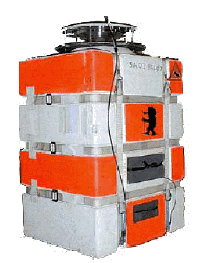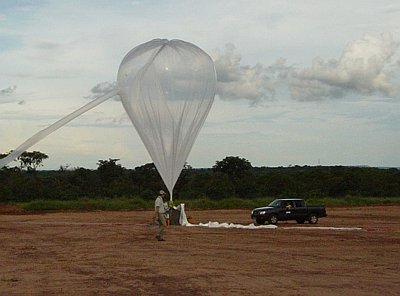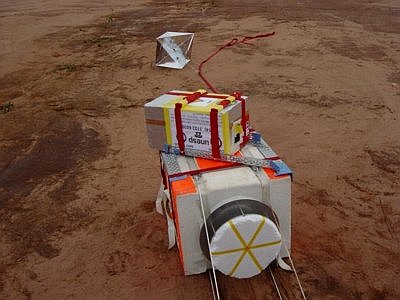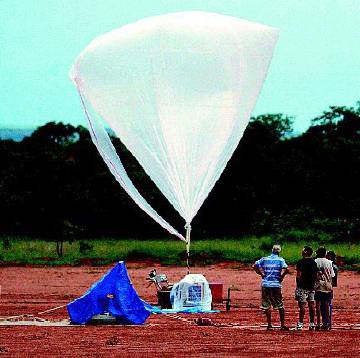Purpose of the flight and payload description
The objective of the flight was the study of vertical transport, water vapour, chemistry, cirrus clouds and electric field associated with convective cells in coordination with Falcon aircraft flights and the ground-based measurements of the TROCCIBRAS project, one of the concurrent scientific efforts which were part of the HIBISCUS project.
The EU HIBISCUS project consisted of a series of field campaigns during the intense convective summers in 2001, 2003 and 2004 in the State of Sao Paulo in Brazil. Its objective was to investigate the impact of deep convection on the Tropical Tropopause Layer (TTL) and the lower stratosphere by providing a new set of observational data on meteorology, tracers of horizontal and vertical transport, water vapour, clouds, and chemistry in the tropical Upper Troposphere/Lower Stratosphere (UT/LS). This was achieved using short duration research balloons to study local phenomena associated with convection over land, and long-duration balloons circumnavigating the globe to study the contrast between land and oceans.
Three instruments were part of this flight:
SAOZ which stands for Systeme d'Analyse par Observation Zenithale and is a UV-visible spectrometer able to provide vertical profiles of O3, NO2, OClO, BrO and H2O by solar occultation during ascent of the balloon (or descent) and from float at 30 km during sunset (or sunrise). The balloon version of the SAOZ instrument is very similar to the one used for ground-based measurements of total ozone and NO2.
It is composed by a commercial flat field, 360mm, holographic grating spectrometer equipped with a 1024-diode linear array and an entrance slit of 50 µm. A simple conical mirror replaces the gondola orientation or sun tracker systems generally used on large balloon platforms and is driven by an on-board computer, connected to a PTU (Pressure, Temperature and Humidity) sensor, a GPS (Global Positioning system ) for the localisation (Altitude, latitude and longitude) and an Argos transmitter for the recovery of the payload after cut-down and descent under parachute.
At left above can be seen a picture of the standard package.The weight of the instrument is 20 Kg and is contained in a insulated box with only a small aperture in the top for capture the solar rays. It's currently flown in three configurations, SaOZ-Standard, SAOZ-BrO and SAOZ-H2O each tuned to a different wavelength for measurements of different atmospheric constituents.
Two SAOZ modules were part of this flight: a standard unit and a SAOZ-BrO which is similar to SAOZ but with some modifications in the spectrometer and the entrance slit to enhance the sensitivity of the instrument to the weak BrO absorption bands.
Finally, LABS a backscatter diode laser developed by the Istituto di Scienze dell'Atmosfera e del Clima (CNR-ISAC) and Ente Nazionale per le Nuove tecnologie, l'Energia e l'Ambiente (ENEA). It provides an in-situ measurement of the aerosol volume backscatter coefficient and aerosol depolarization at 532 nm. The aerosol volume backscatter coefficient detects the presence of aerosols in the air mass sampled, as well as a rough estimation of their quantity. The aerosol depolarization, being the ratio to what extent the main polarization of the laser is preserved in the backscattering process, gives information on the shape of the particles, and in some cases a coarse estimation of their dimensions as well.
Video footage of the launch
Details of the balloon flight
Balloon launched on: 1/31/2004 at 18:30 local
Launch site: Meteorological Research Institute, Baurú, Sao Paulo, Brazil
Balloon launched by: Centre National d'Etudes Spatiales (CNES)
Balloon manufacturer/size/composition: Zero Pressure Balloon model 10zl 10.000 m3
End of flight (L for landing time, W for last contact, otherwise termination time): 31/1/2004 at ~ 20:40 local
Balloon flight duration (F: time at float only, otherwise total flight time in d:days / h:hours or m:minutes - ): 2 h 10 m
Landing site: In a sugar cane field in Paraguaçu Paulista located 100 km from launch site.
Campaign: HIBISCUS
External references
- An overview of the HIBISCUS campaign Atmos. Chem. Phys., 11, 2309, 2011
- Analysis of Stratospheric Bromine Monoxide from SCIAMACHY using Comparison with Model Results Thesis by Ninad V. Sheode, Universitat Bremen, 2006
- Balloon-borne stratospheric BrO measurements: comparison with Envisat/SCIAMACHY BrO limb profiles Atmos. Chem. Phys., 6, 2483-2501, 2006
- HIBISCUS campaign web site Laboratoire Atmosphères, Milieux, Observations Spatiales LATMOS
- Overview of SCIAMACHY validation: 2002-2004 Atmos. Chem. Phys., 6, 127-148, 2006
- SAOZ balloon profiles for the validation of OSIRIS, SCIAMACHY and GOMOS at various latitudes 17th ESA Symposium on European Rocket and Balloon Programmes and Related Research, 30 May - 2 June 2005, Sandefjord, Norway
- Technical Note: Validation of Odin/SMR limb observations of ozone, comparisons with OSIRIS, POAM III, ground-based and balloon-borne instruments Atmos. Chem. Phys., 8, 3385-3409, 2008
225If you consider this website interesting or useful, you can help me to keep it up and running with a small donation to cover the operational costs. Just the equivalent of the price of a cup of coffee helps a lot.





